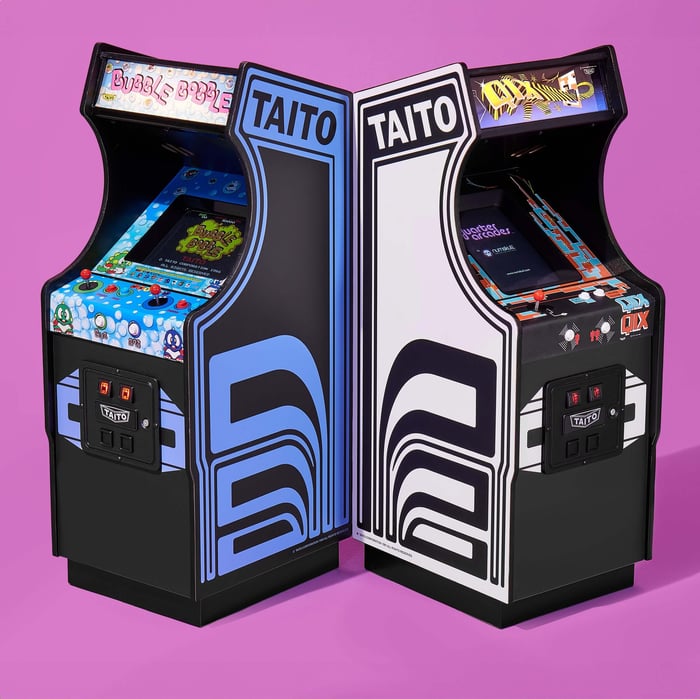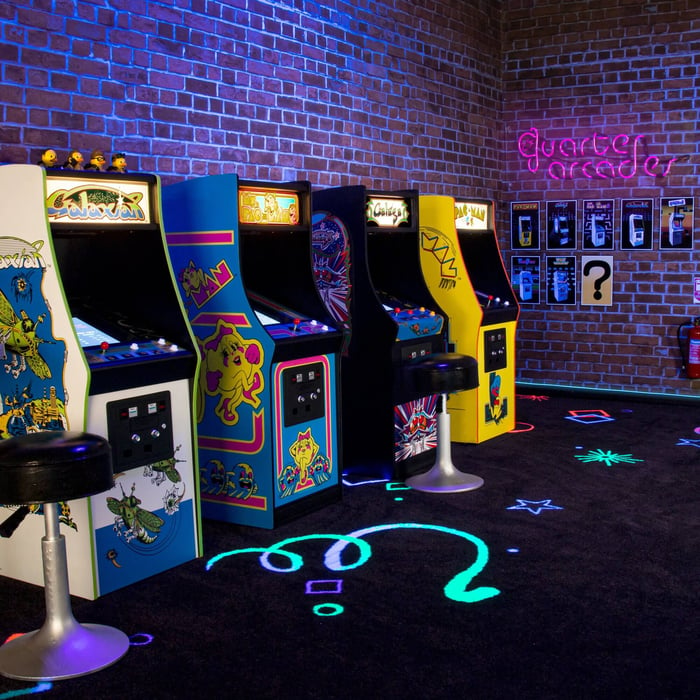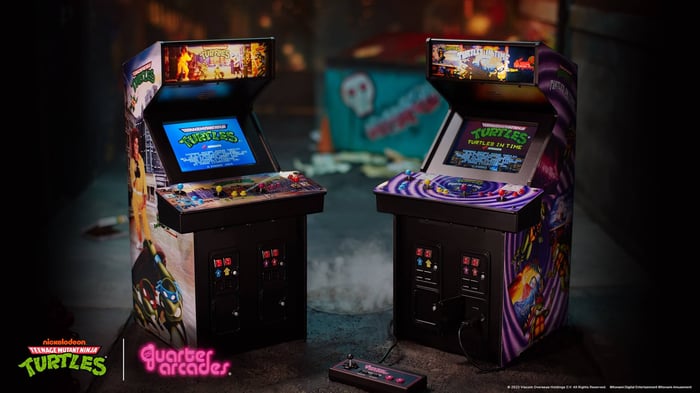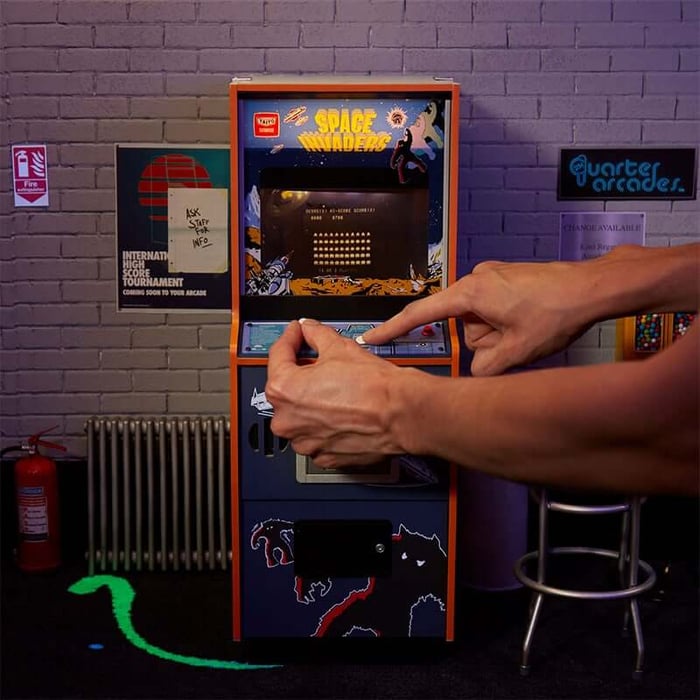Picture yourself standing in front of a towering arcade cabinet in 1982, the marquee glowing overhead whilst the distinct click of microswitched joysticks and the satisfying thunk of authentic arcade buttons fill the air around you.
Now imagine capturing that exact same experience – every sound, every tactile sensation, every pixel-perfect visual detail – and shrinking it down to fit perfectly on your desk whilst maintaining 100% of the original's authenticity.
This is precisely what modern mini-arcades achieve, and understanding how they accomplish this feat reveals the remarkable engineering and attention to detail that separates genuine arcade reproductions from simple gaming gadgets.
Mini-arcades represent far more than scaled-down novelties; they're sophisticated pieces of technology that faithfully recreate the complete sensory experience of classic arcade gaming.
Through a combination of original ROM emulation, authentic materials, and meticulous attention to design details, these compact machines transport players directly back to the golden age of arcade gaming whilst fitting seamlessly into modern homes and offices.
Key Takeaways
• Original ROM emulation ensures perfect authenticity – Premium mini-arcades like Just Geek's Quarter Arcade collection use genuine arcade ROMs running on custom emulation hardware, delivering 100% accurate gameplay that matches the original arcade experience down to precise timing and physics
• Authentic materials and construction recreate the tactile experience – From solid wooden cabinets to microswitched joysticks and properly weighted buttons, every physical element is designed to replicate the feel and response of original arcade machines
• Complete sensory recreation goes beyond gameplay – LED-lit marquees, authentic sound reproduction through quality speakers, and accurate visual displays combine to deliver the full arcade atmosphere in compact form
The Foundation: Original ROM Technology and Authentic Emulation
Understanding the ROM Difference
The most critical element that separates authentic mini-arcades from generic gaming devices lies in their use of original arcade ROMs. When we examine Just Geek's Quarter Arcade collection, we discover that each machine contains the exact same game code that powered the original arcade cabinets decades ago. This isn't a recreation, port, or simplified version – it's the genuine article running on carefully engineered emulation hardware.
Just Geek confirms that Quarter Arcades "use the original arcade ROM on a bespoke emulator, providing 100% accurate emulation." This approach ensures that every aspect of gameplay – from enemy movement patterns to sound timing – remains absolutely faithful to the original arcade experience.
The difference between ROM-based emulation and software ports becomes immediately apparent during gameplay. Original ROMs preserve the precise timing, difficulty curves, and even the subtle quirks that made each arcade game unique. Players can employ the same strategies and patterns they memorised decades ago, because the underlying code remains unchanged.
Custom Emulation Hardware
Premium mini-arcades don't rely on generic emulation software that attempts to handle hundreds of different games. Instead, they utilise custom emulation hardware specifically tuned for individual titles. This dedicated approach eliminates the timing issues, audio lag, and control responsiveness problems that plague multi-game systems attempting to emulate diverse arcade hardware through a single solution.
The Dig Dug Quarter Arcade, for example, features hardware specifically calibrated to reproduce the exact timing and physics of the original 1982 Namco arcade board. This dedicated approach ensures that players experience the game exactly as it was intended, without the compromises inherent in generic emulation solutions.
Authentic Physical Design Elements
Cabinet Construction and Materials
The tactile experience of classic arcade gaming extends far beyond the screen and controls. Original arcade cabinets were substantial pieces of furniture, constructed from solid wood and metal components that provided both durability and the proper acoustic properties for authentic sound reproduction. Mini-arcades capture this essence through careful material selection and construction techniques.
Quarter Arcade machines utilise genuine wooden construction that provides the appropriate weight, feel, and resonance characteristics of full-sized cabinets. This attention to materials extends to metal hardware, proper hinges, and even authentic air vents that replicate the design details of original arcade machines. The result is a miniature cabinet that feels substantial and authentic rather than toylike.
The 1:4 scale proportions maintain the visual relationship between all cabinet elements, ensuring that the marquee, control panel, and screen positioning match the original arcade aesthetic. This precise scaling preserves the visual impact and ergonomic relationships that made original arcade cabinets so appealing.
Control Systems and Tactile Feedback
Perhaps no element is more crucial to the authentic arcade experience than the controls themselves. Original arcade machines featured microswitched joysticks and buttons that provided distinct tactile feedback, allowing players to execute precise movements without looking away from the screen. Mini-arcades recreate this essential element through careful component selection and engineering.
The joysticks in premium mini-arcades utilise actual microswitches rather than the membrane switches found in cheaper alternatives. This ensures the characteristic "click" and precise actuation that made arcade controls so responsive and satisfying to use. Button placement, spacing, and travel distance all follow arcade standards, maintaining the muscle memory and control accuracy that experienced players expect.
Even seemingly minor details like joystick tension and gate configuration receive attention in authentic reproductions. These elements significantly impact gameplay feel and accuracy, particularly in games requiring precise directional inputs or fighting game commands.
| Component | Original Arcade | Premium Mini-Arcade | Generic Alternative |
|---|---|---|---|
| Joystick Type | Microswitched | Microswitched | Membrane/Digital |
| Button Feel | Concave, Weighted | Authentic Recreation | Flat, Light |
| Control Layout | Game-Specific | Accurate Scaling | Generic Arrangement |
| Tactile Response | Distinct Click | Authentic Feel | Mushy/Inconsistent |
| Durability | Commercial Grade | Quality Components | Consumer Grade |
Visual and Audio Recreation
Display Technology and Visual Authenticity
Recreating the visual experience of classic arcade games presents unique challenges, particularly when attempting to capture the distinctive look of CRT monitors using modern LCD technology. Premium mini-arcades address this challenge through careful display selection and calibration that preserves the visual characteristics of original arcade screens.
The Space Invaders Quarter Arcade exemplifies this attention to visual detail. The original Space Invaders cabinet featured a unique "Pepper's Ghost" optical effect that created a semi-transparent display overlay with the background artwork. Numskull's engineers developed innovative LCD solutions to recreate this distinctive visual effect, requiring multiple design iterations to achieve proper transparency and lighting effects.
Modern LCD displays in premium mini-arcades are calibrated to reproduce the colour accuracy, contrast ratios, and viewing angles that characterise classic arcade gaming. Screen positioning and viewing angles maintain the proper relationship between player and display, preserving the ergonomic experience of original arcade gaming.
Authentic Audio Reproduction
The audio experience of classic arcade gaming encompasses far more than just sound effects and music. Original arcade cabinets featured carefully positioned speakers that created immersive soundscapes whilst utilising the cabinet's acoustic properties to enhance bass response and overall audio quality.
Mini-arcades recreate this audio experience through strategically positioned speakers and cabinet design that mimics the acoustic characteristics of full-sized machines. The Bubble Bobble Quarter Arcade features 3W speakers positioned to take advantage of the wooden cabinet's natural resonance, creating surprisingly robust audio reproduction despite its compact size.
Volume controls and audio balance maintain the dynamic range and character of original arcade sound systems, ensuring that iconic sound effects retain their impact and recognition value. The proper audio reproduction extends to subtle elements like the ambient hum of CRT monitors and the electrical characteristics of original audio hardware.
Marquee Lighting and Atmospheric Elements
The illuminated marquee represents one of the most iconic visual elements of classic arcade machines, serving both as identification and atmospheric enhancement. These backlit displays created the distinctive glow that defined arcade aesthetics and helped draw players to specific machines.
Premium mini-arcades recreate this essential element through LED lighting systems that reproduce the warm, consistent illumination of original fluorescent marquee lighting. The QIX Quarter Arcade features accurate marquee artwork provided directly by the original publishers, illuminated by carefully calibrated LED systems that match the colour temperature and intensity of vintage arcade lighting.
Even the power-on sequence and lighting behaviour replicate original arcade machines, with marquees illuminating during startup and maintaining consistent brightness throughout gameplay sessions. These details contribute significantly to the authentic atmosphere that mini-arcades create.
Overcoming Technical Challenges
Scaling Complex Visual Effects
Some classic arcade games incorporated sophisticated visual effects that present significant challenges when adapting to modern display technology. Beyond the Space Invaders Pepper's Ghost effect, games featured unique display characteristics that contributed to their distinctive visual appeal.
Vector graphics games like Tempest utilised specialised monitor technology that created sharp, bright lines impossible to replicate exactly with raster displays. Mini-arcade manufacturers address these challenges through careful software processing and display calibration that approximates the visual characteristics while maintaining gameplay accuracy.
Colour palette accuracy represents another technical challenge, as original arcade monitors often featured unique phosphor characteristics that created distinctive colour reproduction. Modern displays require careful calibration to approximate these characteristics whilst providing the brightness and clarity that contemporary users expect.
Input Lag and Response Time Optimisation
One of the most critical technical challenges in mini-arcade development involves minimising input lag to maintain the precise timing relationships essential to arcade gaming. Original arcade machines featured virtually instantaneous response between control input and screen update, enabling the split-second timing that many classic games require.
Premium mini-arcades address this challenge through optimised emulation code and careful hardware selection that minimises processing delays. The custom emulation approach allows for timing optimisation specific to individual games, ensuring that response characteristics match original arcade specifications.
Display technology selection also impacts input lag, with modern LCD panels requiring careful evaluation to identify models that provide the fastest response times whilst maintaining visual quality. This technical attention ensures that competitive players can employ the same precision techniques that worked on original arcade machines.
Preservation of Gaming Heritage
Authentic Licensing and Legal Compliance
The commitment to authenticity in premium mini-arcades extends beyond technical reproduction to encompass proper licensing and legal compliance with intellectual property rights. This approach ensures that reproductions maintain historical accuracy whilst supporting the original creators and publishers of classic arcade games.
Just Geek's Quarter Arcade collection exemplifies this commitment through official licensing agreements with publishers like Taito, Namco, and Konami. These partnerships provide access to original artwork, ROM files, and technical specifications that enable accurate reproductions whilst ensuring legal compliance and creator compensation.
The licensing approach also guarantees that mini-arcades represent authentic historical records rather than unauthorised copies. This legal foundation provides collectors with confidence in their purchases while supporting the preservation of gaming heritage through proper channels.
Cultural and Historical Significance
Mini-arcades serve an important role in preserving gaming culture for future generations. As original arcade machines become increasingly rare and expensive to maintain, authentic reproductions ensure that classic games remain accessible in their intended formats.
The attention to historical detail in premium mini-arcades extends to packaging, documentation, and collector features that celebrate the cultural significance of classic arcade gaming. Limited production runs, certificates of authenticity, and premium presentation acknowledge the historical importance of these gaming experiences.
This preservation extends beyond mere entertainment to encompass the artistic and technological achievements represented by classic arcade games. Mini-arcades serve as interactive museums that allow people to experience gaming history firsthand rather than simply reading about it.
The Future of Authentic Arcade Recreation
Technological Evolution and Enhanced Features
The mini-arcade industry continues evolving with new technologies that enhance authenticity whilst adding modern conveniences. Recent developments include improved battery technology for extended portable gaming, enhanced connectivity options for firmware updates, and advanced display technologies that more accurately reproduce vintage monitor characteristics.
Future innovations promise even greater authenticity through technologies like haptic feedback systems that recreate the subtle vibrations of original arcade hardware, and advanced audio processing that perfectly reproduces the electrical characteristics of vintage sound systems.
These technological advances ensure that mini-arcades will continue improving their authentic recreation of classic arcade experiences whilst maintaining the historical accuracy that defines premium reproductions.
Expanding Game Libraries and Preservation Efforts
The success of authentic mini-arcade reproductions has encouraged publishers to make more classic titles available for proper reproduction. This trend benefits both collectors and gaming preservation efforts by ensuring that important gaming history remains accessible through authentic channels.
Upcoming releases promise to include even more beloved classic titles, each receiving the same meticulous attention to authenticity that characterises existing premium mini-arcades. This expansion ensures that the complete history of arcade gaming can be preserved and enjoyed by future generations.
The growing recognition of video games as legitimate cultural artefacts further supports these preservation efforts, encouraging investment in authentic reproduction technologies and proper historical documentation.
Conclusion
Mini-arcades capture the essence of classic arcade experiences through an unwavering commitment to authenticity that encompasses every aspect of the original gaming environment. From the use of genuine arcade ROMs and custom emulation hardware to the careful recreation of tactile controls and atmospheric elements, these remarkable machines prove that size doesn't compromise authenticity when proper attention is paid to engineering and design details.
The success of premium mini-arcades like Just Geek's Quarter Arcade collection demonstrates that there's significant value in prioritising authenticity over convenience. By focusing on faithful reproduction rather than feature cramming, these machines deliver experiences that genuinely transport players back to the golden age of arcade gaming whilst fitting seamlessly into modern lifestyles.
For collectors, gaming enthusiasts, and anyone interested in experiencing gaming history as it was meant to be enjoyed, authentic mini-arcades represent the perfect solution that preserves the past while embracing the future.
Ready to experience authentic arcade gaming for yourself? Explore the complete Quarter Arcade collection at Just Geek and discover how these remarkable machines capture the true essence of classic arcade experiences.
Frequently Asked Questions
How accurate are mini-arcades compared to original arcade machines?
Premium mini-arcades like the Quarter Arcade collection achieve remarkable accuracy by using original arcade ROMs running on custom emulation hardware designed for 100% authentic gameplay. The physical construction, controls, and audio systems are carefully engineered to recreate the complete sensory experience of original arcade machines, making them virtually indistinguishable from the originals in terms of gameplay feel.
What's the difference between ROM-based emulation and software ports in mini-arcades?
ROM-based emulation uses the exact same game code that powered original arcade machines, running through specialised hardware that recreates the original arcade board behaviour. Software ports involve rewriting games for different platforms, which can introduce timing changes, control differences, and other alterations. ROM-based systems preserve the authentic arcade experience exactly as it was originally designed.
Do mini-arcades require any special setup or maintenance?
Modern mini-arcades are designed for immediate plug-and-play operation with minimal setup required. Most feature rechargeable batteries for portable use and simple charging systems. Maintenance involves basic cleaning and occasional battery charging, with the solid construction ensuring years of reliable operation without significant intervention.
Can mini-arcades play multiple games or are they single-game machines?
Premium mini-arcades like Quarter Arcade machines are typically dedicated to single games to ensure maximum authenticity and optimal hardware configuration for each specific title. This approach allows for perfect emulation accuracy and authentic cabinet artwork, though some manufacturers offer multi-game alternatives that compromise on authenticity for variety.
Are mini-arcades worth the investment compared to other retro gaming options?
Mini-arcades offer unique value through their combination of authentic arcade experience, space-efficient design, and collector appeal. While more expensive than software emulation or handheld devices, they provide the complete tactile and visual experience of arcade gaming that other options cannot match. For serious collectors and arcade enthusiasts, the investment in authenticity and build quality typically justifies the premium pricing.




















